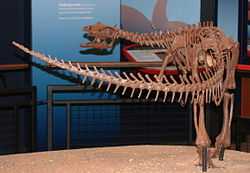Thescelosauridae
| Thescelosauridae Temporal range: Early Cretaceous–Late Cretaceous, 130–65.5Ma | |
|---|---|
 | |
| Mounted specimen of Thescelosaurus, Burpee Museum of Natural History | |
| Scientific classification | |
| Kingdom: | Animalia |
| Phylum: | Chordata |
| Clade: | Dinosauria |
| Order: | †Ornithischia |
| Clade: | †Ornithopoda |
| Family: | †Thescelosauridae Sternberg, 1937 |
| Type species | |
| †Thescelosaurus neglectus Gilmore, 1913 | |
| Subfamilies | |
|
†Orodrominae Brown et al., 2013 | |
Thescelosauridae is a clade or family of small ornithopod ornithischians which have previously been generally allied to hypsilophodontids.
Classification
| ||||||||||||||||||||||||||||||||||||||||||||||||
| This cladogram is from Brown et al., (2013).[1] |
Although Hypsilophodontidae was interpreted as a natural group in the early 1990s,[2][3] this hypothesis has fallen out of favor and Hypsilophodontidae has been found to be an unnatural family composed of a variety of animals more or less closely related to Iguanodontia (paraphyly), with various small clades of closely related taxa.[4][5][6][7][8] "Hypsilophodontidae" and "hypsilophodont" are better understood as informal terms for an evolutionary grade, not a true clade. Thescelosaurus has been regarded as both very basal[3] and very derived[6] among the hypsilophodonts. One issue that has potentially interfered with classifying Thescelosaurus is that not all of the remains assigned to T. neglectus necessarily belong to it.[9] Clint Boyd and colleagues found that while the clade Thescelosaurus included the genus Bugenasaura and the species that had been assigned to that genus, there were at least two and possibly three species within Thescelosaurus, and several specimens previously assigned to T. neglectus could not yet be assigned to a species within the genus.[4] It appears to be closely related to Parksosaurus.[4][6][7][10][11]
The dissolution of Hypsilophodontidae has been followed by the recognition of the distinct family Thescelosauridae. This area of the dinosaur family tree has historically been complicated by a lack of research, but papers by Clint Boyd and colleagues[4] and Caleb Brown and colleagues[10][11] have specifically addressed these dinosaurs. Boyd et al. (2009) and Brown et al. (2011) found North American "hypsilophodonts" of Cretaceous age to sort into two related clusters, one consisting of Orodromeus, Oryctodromeus, and Zephyrosaurus, and the other consisting of Parksosaurus and Thescelosaurus.[4][10] Brown et al. (2013) recovered similar results, with the addition of the new genus Albertadromeus to the Orodromeus clade and several long-snouted Asian forms (previously described under Jeholosauridae)[5] to the Thescelosaurus clade. They also formally defined Thescelosauridae (Thescelosaurus neglectus, Orodromeus makelai, their most recent common ancestor, and all descendants) and the smaller clades Orodrominae and Thescelosaurinae.[11]
References
- ↑ Brown, C. M.; Evans, D. C.; Ryan, M. J.; Russell, A. P. (2013). "New data on the diversity and abundance of small-bodied ornithopods (Dinosauria, Ornithischia) from the Belly River Group (Campanian) of Alberta". Journal of Vertebrate Paleontology 33 (3): 495. doi:10.1080/02724634.2013.746229.
- ↑ Sues, Hans-Dieter; and Norman, David B. (1990). "Hypsilophodontidae, Tenontosaurus, Dryosauridae". In Weishampel, David B.; Dodson, Peter; and Osmólska, Halszka (eds.). The Dinosauria (1st ed.). Berkeley: University of California Press. pp. 498–509. ISBN 0-520-06727-4.
- ↑ 3.0 3.1 Weishampel, David B.; and Heinrich, Ronald E. (1992). "Systematics of Hypsilophodontidae and Basal Iguanodontia (Dinosauria: Ornithopoda)" (PDF). Historical Biology 6 (3): 159–184. doi:10.1080/10292389209380426. Retrieved 2007-03-10.
- ↑ 4.0 4.1 4.2 4.3 4.4 Boyd, Clint A.; Brown, Caleb M.; Scheetz, Rodney D.; and Clarke, Julia A. (2009). "Taxonomic revision of the basal neornithischian taxa Thescelosaurus and Bugenasaura". Journal of Vertebrate Paleontology 29 (3): 758–770. doi:10.1671/039.029.0328.
- ↑ 5.0 5.1 Han, Feng-Lu; Paul M. Barrett, Richard J. Butler, and Xing Xu (2012). "Postcranial anatomy of Jeholosaurus shangyuanensis (Dinosauria, Ornithischia) from the Lower Cretaceous Yixian Formation of China". Journal of Vertebrate Paleontology 32 (6): 1370–1395. doi:10.1080/02724634.2012.694385.
- ↑ 6.0 6.1 6.2 Norman, David B.; Sues, Hans-Dieter; Witmer, Larry M.; and Coria, Rodolfo A. (2004). "Basal Ornithopoda". In Weishampel, David B.; Dodson, Peter; and Osmólska, Halszka (eds.). The Dinosauria (2nd ed.). Berkeley: University of California Press. pp. 393–412. ISBN 0-520-24209-2.
- ↑ 7.0 7.1 Weishampel, David B.; Jianu, Coralia-Maria; Csiki, Z.; and Norman, David B. (2003). "Osteology and phylogeny of Zalmoxes (n.g.), an unusual euornithopod dinosaur from the latest Cretaceous of Romania". Journal of Systematic Palaeontology 1 (2): 1–56. doi:10.1017/S1477201903001032.
- ↑ Varricchio, David J.; Martin, Anthony J.; and Katsura, Yoshihiro (2007). "First trace and body fossil evidence of a burrowing, denning dinosaur" (PDF). Proceedings of the Royal Society B: Biological Sciences 274 (1616): 1361–1368. doi:10.1098/rspb.2006.0443. PMC 2176205. PMID 17374596. Retrieved 2007-03-22.
- ↑ Butler, Richard J.; Upchurch, Paul; and Norman, David B. (2008). "The phylogeny of the ornithischian dinosaurs". Journal of Systematic Palaeontology 6 (1): 1–40. doi:10.1017/S1477201907002271.
- ↑ 10.0 10.1 10.2 Brown; Caleb M.; Boyd, Clint A.; and Russell, Anthony P. (2011). "A new basal ornithopod dinosaur (Frenchman Formation, Saskatchewan, Canada), and implications for late Maastrichtian ornithischian diversity in North America". Zoological Journal of the Linnean Society 163 (4): 1157–1198. doi:10.1111/j.1096-3642.2011.00735.x.
- ↑ 11.0 11.1 11.2 Brown, Caleb Marshall; Evans, David C.; Ryan, Michael J.; and Russell, Anthony P. (2013). "New data on the diversity and abundance of small-bodied ornithopods (Dinosauria, Ornithischia) from the Belly River Group (Campanian) of Alberta". Journal of Vertebrate Paleontology 33 (3): 495–520. doi:10.1080/02724634.2013.746229.